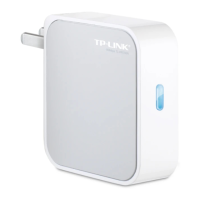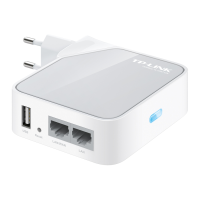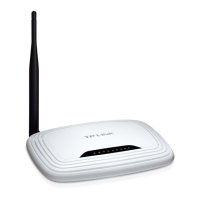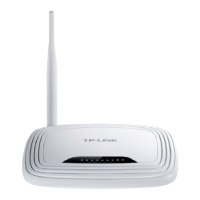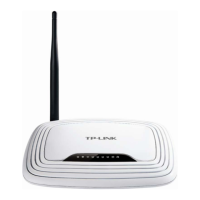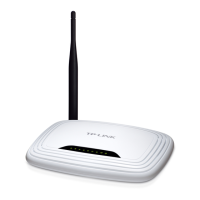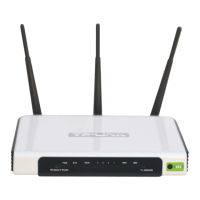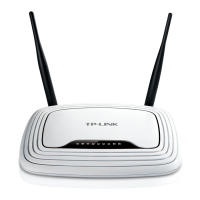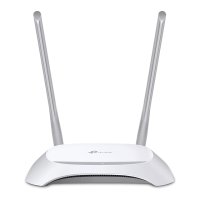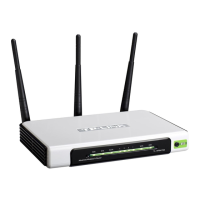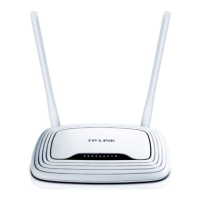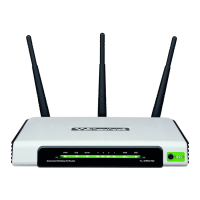Do you have a question about the TP-Link TL-WR720N and is the answer not in the manual?
FCC compliance statement for digital devices, including interference guidelines and user responsibilities.
Warning regarding Class B product and potential radio interference in domestic environments.
Lists national limitations and remarks for EU countries regarding wireless device usage.
Warning about potential radio interference in Korean for wireless equipment.
Notice regarding frequency modification and safe operation of low-power RF devices in Taiwan.
Lists all items included in the product package, including the router and accessories.
Provides a general overview of the 150Mbps Wireless N Router's features and capabilities.
Explains terminology and abbreviations used throughout the user guide for clarity.
Details the key features and specifications of the TL-WR720N router, such as data rate and security.
Details the LEDs and WPS button located on the front panel of the router.
Details the ports and buttons located on the rear panel of the router, including WPS/RESET and power.
Lists the necessary hardware and software requirements for connecting the router.
Specifies optimal conditions for installing the router, including ventilation and temperature.
Provides step-by-step instructions for physically connecting the router to your network and power.
Explains how to configure TCP/IP settings on your PC for network connection with the router.
Guides users through the initial setup and configuration of the router using the web interface.
Instructions on how to log in to the router's web-based management interface.
Describes the Status page, which provides read-only information about the router's current state.
Guides users through a simplified setup process for basic router configuration.
Explains the Wi-Fi Protected Setup (WPS) function for easy connection of wireless devices.
Network configuration settings including LAN, WAN, and MAC Clone.
Configuration settings for the Local Area Network (LAN) interface of the router.
Configuration settings for the Wide Area Network (WAN) connection, including PPPoE, Dynamic IP, and Static IP.
Allows cloning the MAC address of a PC to the router's WAN port, often required by ISPs.
Wireless network configuration settings, including security and advanced options.
Configuration of basic wireless network parameters like SSID, region, channel, and mode.
Setup for wireless security protocols such as WEP, WPA, WPA2, and WPA-PSK.
Controls access to the wireless network based on the MAC addresses of connected devices.
Advanced wireless settings including transmit power, beacon interval, and fragmentation threshold.
Displays statistics for connected wireless stations, including MAC address and packet counts.
DHCP server configuration, client list, and address reservation.
Configuration for the DHCP server, which automatically assigns IP addresses to devices on the LAN.
Lists devices currently connected to the network via DHCP, showing their IP and MAC addresses.
Allows reserving specific IP addresses for devices on the LAN, ensuring consistent IP assignment.
Port forwarding settings including Virtual Servers, Port Triggering, DMZ, and UPnP.
Configures virtual servers to allow external access to specific services on internal LAN computers.
Sets up port triggering for applications requiring multiple dynamic connections, like online games.
Configures the DMZ host feature to expose a local host to the Internet for special-purpose services.
Enables Universal Plug and Play for automatic discovery and configuration of network devices.
Security settings including firewall, IP/domain/MAC filtering, and advanced protection.
Enables and configures the router's firewall to protect the network from unauthorized access.
Controls internet access based on specific IP addresses or ranges on the LAN.
Restricts access to specific websites by domain name or keywords.
Controls internet access based on the MAC addresses of connected devices.
Configures access rules for managing the router's web utility from the local network.
Allows managing the router remotely over the internet by configuring web management port and IP.
Provides advanced security features like DoS protection, SYN Flood, UDP Flood, and ICMP-Flood filtering.
Sets up rules to control children's internet activities, restricting websites and surfing times.
Defines rules for controlling internet access based on hosts, targets, and schedules.
Defines rules for controlling internet access based on hosts, targets, and schedules.
Manages a list of hosts (devices) that can be used in access control rules, by IP or MAC address.
Defines targets for access control rules, specifying IP addresses, domain names, or ports.
Creates schedules for when access control rules should be active, specifying days and times.
Configures static routes to define specific paths for network traffic to reach hosts or networks.
Configures Quality of Service (QoS) to prioritize network traffic based on IP address, bandwidth, and mode.
Associates specific IP addresses with MAC addresses to prevent unauthorized devices from accessing the network.
Associates specific IP addresses with MAC addresses to prevent unauthorized devices from accessing the network.
Displays the ARP list showing relationships between IP and MAC addresses on the LAN.
Dynamic DNS configuration for services like Comexe.cn, Dyndns.org, and No-ip.com.
Configuration for the Comexe.cn Dynamic DNS service to map a dynamic IP to a fixed domain name.
Configuration for the Dyndns.org Dynamic DNS service to map a dynamic IP to a fixed domain name.
Configuration for the No-ip.com Dynamic DNS service to map a dynamic IP to a fixed domain name.
System tools for managing router settings, including time, diagnostics, firmware, and logs.
Configures the router's time and date, including NTP server settings and Daylight Saving.
Tools for diagnosing network connectivity issues, including Ping and Traceroute.
Instructions for updating the router's firmware to the latest version.
Resets the router's configuration settings to their original factory default values.
Saves router configuration settings to a backup file and restores them when needed.
Restarts the router, which is necessary for some configuration changes to take effect.
Allows changing the router's default login username and password for enhanced security.
Views system logs to monitor router events, errors, and status information.
Displays network traffic statistics, including total traffic and current packet statistics.
FCC compliance statement for digital devices, including interference guidelines and user responsibilities.
Warning regarding Class B product and potential radio interference in domestic environments.
Lists national limitations and remarks for EU countries regarding wireless device usage.
Warning about potential radio interference in Korean for wireless equipment.
Notice regarding frequency modification and safe operation of low-power RF devices in Taiwan.
Lists all items included in the product package, including the router and accessories.
Provides a general overview of the 150Mbps Wireless N Router's features and capabilities.
Explains terminology and abbreviations used throughout the user guide for clarity.
Details the key features and specifications of the TL-WR720N router, such as data rate and security.
Details the LEDs and WPS button located on the front panel of the router.
Details the ports and buttons located on the rear panel of the router, including WPS/RESET and power.
Lists the necessary hardware and software requirements for connecting the router.
Specifies optimal conditions for installing the router, including ventilation and temperature.
Provides step-by-step instructions for physically connecting the router to your network and power.
Explains how to configure TCP/IP settings on your PC for network connection with the router.
Guides users through the initial setup and configuration of the router using the web interface.
Instructions on how to log in to the router's web-based management interface.
Describes the Status page, which provides read-only information about the router's current state.
Guides users through a simplified setup process for basic router configuration.
Explains the Wi-Fi Protected Setup (WPS) function for easy connection of wireless devices.
Network configuration settings including LAN, WAN, and MAC Clone.
Configuration settings for the Local Area Network (LAN) interface of the router.
Configuration settings for the Wide Area Network (WAN) connection, including PPPoE, Dynamic IP, and Static IP.
Allows cloning the MAC address of a PC to the router's WAN port, often required by ISPs.
Wireless network configuration settings, including security and advanced options.
Configuration of basic wireless network parameters like SSID, region, channel, and mode.
Setup for wireless security protocols such as WEP, WPA, WPA2, and WPA-PSK.
Controls access to the wireless network based on the MAC addresses of connected devices.
Advanced wireless settings including transmit power, beacon interval, and fragmentation threshold.
Displays statistics for connected wireless stations, including MAC address and packet counts.
DHCP server configuration, client list, and address reservation.
Configuration for the DHCP server, which automatically assigns IP addresses to devices on the LAN.
Lists devices currently connected to the network via DHCP, showing their IP and MAC addresses.
Allows reserving specific IP addresses for devices on the LAN, ensuring consistent IP assignment.
Port forwarding settings including Virtual Servers, Port Triggering, DMZ, and UPnP.
Configures virtual servers to allow external access to specific services on internal LAN computers.
Sets up port triggering for applications requiring multiple dynamic connections, like online games.
Configures the DMZ host feature to expose a local host to the Internet for special-purpose services.
Enables Universal Plug and Play for automatic discovery and configuration of network devices.
Security settings including firewall, IP/domain/MAC filtering, and advanced protection.
Enables and configures the router's firewall to protect the network from unauthorized access.
Controls internet access based on specific IP addresses or ranges on the LAN.
Restricts access to specific websites by domain name or keywords.
Controls internet access based on the MAC addresses of connected devices.
Configures access rules for managing the router's web utility from the local network.
Allows managing the router remotely over the internet by configuring web management port and IP.
Provides advanced security features like DoS protection, SYN Flood, UDP Flood, and ICMP-Flood filtering.
Sets up rules to control children's internet activities, restricting websites and surfing times.
Defines rules for controlling internet access based on hosts, targets, and schedules.
Defines rules for controlling internet access based on hosts, targets, and schedules.
Manages a list of hosts (devices) that can be used in access control rules, by IP or MAC address.
Defines targets for access control rules, specifying IP addresses, domain names, or ports.
Creates schedules for when access control rules should be active, specifying days and times.
Configures static routes to define specific paths for network traffic to reach hosts or networks.
Configures Quality of Service (QoS) to prioritize network traffic based on IP address, bandwidth, and mode.
Associates specific IP addresses with MAC addresses to prevent unauthorized devices from accessing the network.
Associates specific IP addresses with MAC addresses to prevent unauthorized devices from accessing the network.
Displays the ARP list showing relationships between IP and MAC addresses on the LAN.
Dynamic DNS configuration for services like Comexe.cn, Dyndns.org, and No-ip.com.
Configuration for the Comexe.cn Dynamic DNS service to map a dynamic IP to a fixed domain name.
Configuration for the Dyndns.org Dynamic DNS service to map a dynamic IP to a fixed domain name.
Configuration for the No-ip.com Dynamic DNS service to map a dynamic IP to a fixed domain name.
System tools for managing router settings, including time, diagnostics, firmware, and logs.
Configures the router's time and date, including NTP server settings and Daylight Saving.
Tools for diagnosing network connectivity issues, including Ping and Traceroute.
Instructions for updating the router's firmware to the latest version.
Resets the router's configuration settings to their original factory default values.
Saves router configuration settings to a backup file and restores them when needed.
Restarts the router, which is necessary for some configuration changes to take effect.
Allows changing the router's default login username and password for enhanced security.
Views system logs to monitor router events, errors, and status information.
Displays network traffic statistics, including total traffic and current packet statistics.
| Ethernet LAN | Yes |
|---|---|
| Cabling technology | 10/100Base-T(X) |
| Networking standards | IEEE 802.11b, IEEE 802.11g, IEEE 802.11n, IEEE 802.3, IEEE 802.3u |
| Receiver sensitivity | 130M: -68dBm@10% PER 108M: -68dBm@10% PER 54M: -68dBm@10% PER 11M: -85dBm@8% PER 6M: -88dBm@10% PER 1M: -90dBm@8% PER |
| Ethernet LAN data rates | 10, 100 Mbit/s |
| Ethernet LAN interface type | Fast Ethernet |
| Wi-Fi band | Single-band (2.4 GHz) |
| Wi-Fi standards | 802.11b, 802.11g, Wi-Fi 4 (802.11n) |
| Top Wi-Fi standard | Wi-Fi 4 (802.11n) |
| WLAN data transfer rate (max) | 150 Mbit/s |
| Frequency range | 2.4 - 2.4835 GHz |
| WLAN data transfer rates supported | 11, 54, 150 Mbit/s |
| USB port | No |
| Ethernet LAN (RJ-45) ports | 2 |
| Supported network protocols | PPTP, L2TP, IPSec, TCP/IP, DHCP, PPPoE |
| Security algorithms | 64-bit WEP, 128-bit WEP, 152-bit WEP, WDS, WEP, WPA-PSK, WPA2, WPA2-PSK |
| Certification | CE, FCC, RoHS |
| Storage temperature (T-T) | -20 - 70 °C |
| Operating temperature (T-T) | 0 - 40 °C |
| Storage relative humidity (H-H) | 5 - 95 % |
| Operating relative humidity (H-H) | 10 - 90 % |
| Product type | Tabletop router |
| Product color | White |
| Cables included | LAN (RJ-45) |
| Windows operating systems supported | Windows 7 Home Premium, Windows 7 Home Premium x64, Windows 7 Professional, Windows 7 Professional x64, Windows 7 Starter, Windows 7 Starter x64, Windows 7 Ultimate, Windows 7 Ultimate x64, Windows Vista Business x64, Windows Vista Home Basic, Windows Vista Home Basic x64, Windows Vista Home Premium, Windows Vista Home Premium x64, Windows Vista Ultimate, Windows Vista Ultimate x64, Windows XP Home, Windows XP Home x64, Windows XP Professional, Windows XP Professional x64 |
| Antenna gain level (max) | 5 dBi |
| Output current | 0.6 A |
| Output voltage | 5 V |
| Power source type | AC |
| Depth | 122 mm |
|---|---|
| Width | 158 mm |
| Height | 32 mm |
| Weight | - g |
